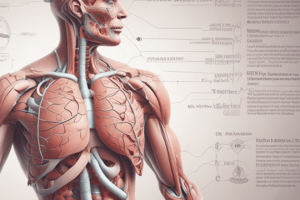Podcast
Questions and Answers
What is the term for the process of taking air into the lungs?
What is the term for the process of taking air into the lungs?
- Breathing
- Inhalation (correct)
- Respiration
- Exhalation
How many lungs do humans have?
How many lungs do humans have?
- One
- Two (correct)
- Three
- Four
What happens when you breathe out?
What happens when you breathe out?
- You hold your breath
- You take air in
- You get air out (correct)
- You cough
What is the opposite of inhalation?
What is the opposite of inhalation?
What is the term for the process of getting air out of the lungs?
What is the term for the process of getting air out of the lungs?
What is the definition of mechanics?
What is the definition of mechanics?
What is the mathematical representation of Newton's second law?
What is the mathematical representation of Newton's second law?
What happens to an object when it is acted upon by an unbalanced force?
What happens to an object when it is acted upon by an unbalanced force?
What type of force is responsible for an object's resistance to motion?
What type of force is responsible for an object's resistance to motion?
What is the term for a change in speed?
What is the term for a change in speed?
Flashcards are hidden until you start studying
Study Notes
Human Body: Lungs
- The process of taking air into the lungs is called inhalation.
- The process of getting air out of the lungs is called exhalation.
- The human body has two lungs, which are referred to as "twin lungs".
- When we breathe in, we take air into our lungs.
- When we breathe out, we get air out of our lungs.
Newton's Laws
- An object at rest will remain at rest, and an object in motion will continue to move with a constant velocity, unless acted upon by an unbalanced force.
- An object's motion will change when an unbalanced force is applied, resulting in a change in speed and direction.
Newton's Second Law
- Force (F) is equal to mass (m) times acceleration (a), represented by the equation F = ma.
- A change in an object's motion is directly proportional to the force applied.
Newton's Third Law
- For every action, there is an equal and opposite reaction.
Mechanics
- The study of how objects move or remain stationary when forces act upon them.
Applications of Newton's Laws
- Engineers apply Newton's laws to design and develop systems, structures, and machines.
Types of Force
- Friction: a force that opposes motion.
- Static friction: a force that prevents an object from moving when a force is applied.
- Dynamic friction: a force that opposes motion when an object is already moving.
Motion
- Speed: the rate at which an object moves.
- Velocity: the speed of an object in a specific direction.
- Acceleration: the change in speed or velocity of an object over time.
Studying That Suits You
Use AI to generate personalized quizzes and flashcards to suit your learning preferences.



